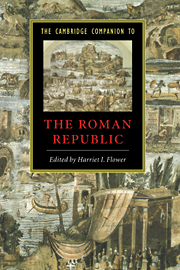Book contents
- Frontmatter
- Introduction
- PART 1 POLITICAL AND MILITARY HISTORY
- PART 2 ROMAN SOCIETY
- 5 Under Roman Roofs: Family, House, and Household
- 6 Women in the Roman Republic
- 7 The Republican Economy and Roman Law: Regulation, Promotion, or Reflection?
- 8 Roman Religion
- PART 3 ROME'S EMPIRE
- PART 4 ROMAN CULTURE
- PART 5 EPILOGUE: THE INFLUENCE OF THE ROMAN REPUBLIC
- Timeline
- Bibliography
- Index
5 - Under Roman Roofs: Family, House, and Household
from PART 2 - ROMAN SOCIETY
Published online by Cambridge University Press: 28 May 2006
- Frontmatter
- Introduction
- PART 1 POLITICAL AND MILITARY HISTORY
- PART 2 ROMAN SOCIETY
- 5 Under Roman Roofs: Family, House, and Household
- 6 Women in the Roman Republic
- 7 The Republican Economy and Roman Law: Regulation, Promotion, or Reflection?
- 8 Roman Religion
- PART 3 ROME'S EMPIRE
- PART 4 ROMAN CULTURE
- PART 5 EPILOGUE: THE INFLUENCE OF THE ROMAN REPUBLIC
- Timeline
- Bibliography
- Index
Summary
INTRODUCTION: THE PARADIGM OF PATRIARCHY
It is a truism that the family forms the basic unit of any society and, at the same time, reflects its ruling principles, values, and views, and this is certainly true of Rome. As in all societies, the structure of the basic family unit was made up of a complex compound of criteria and factors that, in their relative importance to the whole as well as individually, could and did differ considerably at any given period and were subject to change over time. Legal status, age and gender, wealth, social standing and rank, traditions and ideologies, attitudes and patterns of behaviour based on them determined the position of a Roman, male or female, in society as well as in his or her family. Republican society at large was characterized by the omnipresence of hierarchies and of overlapping power relations. Distinctions of status and rank abounded, not only between Roman citizens or provincials and the mass of slaves with no rights, but also between magistrates and ordinary citizens, between generals and soldiers, patrons and clients, senators and the plebs in the Roman street, and even within the privileged classes.
The image and idea of the Roman family was deeply influenced by a combination of hierarchy and power. At least in law and in ideology, all relations within the household centred on authority, obligation, and coercion. The aristocratic value system was defined by a number of traditional factors: superiority, rank, authority, talent, and achievement in the service to the state (res publica), on the one hand, balanced by subordination, acceptance, and deference, on the other.
- Type
- Chapter
- Information
- The Cambridge Companion to the Roman Republic , pp. 113 - 138Publisher: Cambridge University PressPrint publication year: 2004
- 3
- Cited by

